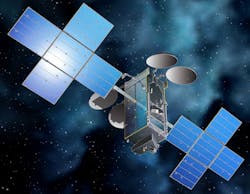A 22,300 Mile High Network Backup Plan
Before we go too far into this, if it’s safe to do so, look up at the sky. You can’t see them easily but there’s a mess of satellites “floating” geosynchronous above the U.S. Some are there to help the local weatherman report tomorrow’s weather while others handle a massive amount of data up and back down to the surface. One in particular, EchoStar 19—one of the youngest in the sky—took flight Dec. 18, 2016. Before I get into what this satellite can do, let me tell you about the plans Hughes Network Systems has in mind.
Along with a consumer business, Hughes’ Government Solutions group provides a subscription-based service for public safety. In a March 30 press release, they report that “HughesNet Gen5 is the first and only U.S. satellite internet service to offer Federal Communications Commission-defined broadband speeds.” That’s broadband. From space.
With new generation technology always on the horizon and FirstNet around the corner, IP networks need a backup in event of a catastrophic event. Think flooding, tornadoes, hurricanes, or simply someone slicing your fiber with a backhoe. The 911 system should be a mainstay and the last network to fail serving your community. Even with an extensive multiple point design, a single-threaded terrestrial-based network still has that vulnerability of being on the ground.
“That’s the part where we’re addressing,” says Tony Bardo, assistant vice president, Government Solutions at Hughes Netowrk Systems. “That’s the part where we can come in and make that network more resilient for all the IP technology, the data center technology…and the ability to handle the voice and data and data and pictures and so forth.” Their satellite back up offers an ability for 911 calls to switch technology and keep the emergency service coverage alive.
Like a router in the sky
EchoStar 19 isn’t alone. It joins EchoStar 17 and the Spaceway 3 satellite. Spaceway 3 was launched ten years ago and according to Bardo still has a five years of life. The typical satellite has an average 17-year life expectancy. However, it’s tough to say. Technology may allow satellites to be relevant longer.
“They’re getting bigger, faster, and getting able to handle more and more calls,” says Bardo. He explains that Spaceway had close to a million subscribers and covered the lower 48 states, some of the Caribbean and Alaska. “[It] was built with 10 GB of capacity. That was the size of seven or eight of the traditional older style of satellites that were flying over North America. In 2012, when we launched EchoStar 17, that was 120 GB of capacity. EchoStar 19 is 220 GB of capacity.” While an estimation of how many subscribers EchoStar 19 will be able to handle was not available, one might be safe guessing a lot.
Spaceway offers a capacity of 3 MB up and 8 MB down (from a customer dish and returning). In contrast, EchoStar 19 offers 3 MG up and 25 MB down—more than a triple technological increase in a decade.
With both satellites in operation, Hughes plans to work them in tandem to offer national coverage.
Service
Hughes offers public safety emergency communication customers the max access speed off the bat. The price, however, can vary depending on the size of the site. The company plans on providing everyone with the same speed (3 /25), but monthly rates would depend on data allocation. And having a satellite as insurance for your emergency communication network isn’t as expensive as you might think. Some customers run the service statewide, while others keep it local.
But the company doesn’t only offer a backup plan for your 911 network. Hughes makes available internet coverage as well for those unserved (or unservable) by way of limiting geography. Bardo explains he’s trying to open the service for rural K to 12 schools for high capacity broadband internet. The same dedicated capacity can be offered for rural law enforcement agencies.
“One of our customers is the Texas Department of Public Safety (TDPS),” says Bardo. “We provide service to over 850 sites throughout the state with dedicated capacity.” Yet, TDPS aren’t using a satellite as sole source—they do have a terrestrial network—it’s a backup plan. And this backup plan is important. After Katrina, Bardo sat on a US Chamber of Commerce panel discussing network resiliency. There, a communication manager of a nationwide retail chain told a story of how he was able to continue offering services like food, water, pharmaceuticals, and cash from the ATM when competing stores closed their doors. “It’s insurance. You’re not using it every day because the terrestrial networks are really well done. But for a bad day, here you have an ability to keep going either for your business or for your public sector role of servicing citizens,” says Bardo.
As stated in their March 30 press release, “The new capabilities of HughesNet Gen5 provides agencies with a path-diverse back-up connection, allowing them to keep mission-critical applications online over satellite connections until the primary network outage is restored.”
“[Satellites] never get flooded. They never catch on fire. They’re 22,000 miles out of harm’s way,” Bardo says. “[They are not there] as a complete solution. What works is a combination of technologies purchased from companies that are excellent in their part. That’s how you put together a network that has teeth, resiliency and continuity.”
To put it in other terms a bit more exaggerated, he adds, “Until we populate the moon or have a manned station on Mars, there are no backhoes in space, yet.”
About the Author

Jonathan Kozlowski
Jonathan Kozlowski was with Officer.com, Law Enforcement Technology, and Law Enforcement Product News from August 2006 to 2020.
As former Managing Editor for Officer Media Group, he brought a dedicated focus to the production of the print publications and management of the Officer.com online product and company directory. You can connect with Jonathan through LinkedIn.
Jonathan participated as a judge for the 2019 and 2020 FOLIO: Eddie & Ozzie Awards. In 2012, he received an APEX Award of Excellence in the Technology & Science Writing category for his article on unmanned aerial vehicles (UAVs) in police work, aptly titled "No Runway Needed".
